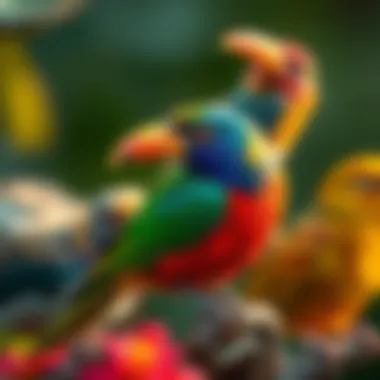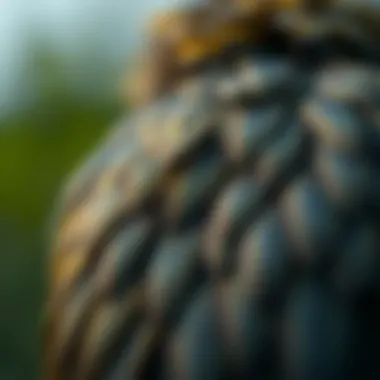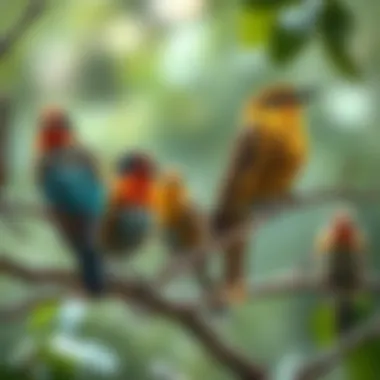Discovering the Intriguing World of Bird Names


Intro
Birds have an irrefutable charm that captivates many, paying homage to their beauty and eloquence. Within this avian paradise, there exists an equally fascinating realm: unique bird names. These names aren’t just labels; they hold stories, histories, and rich cultural significance. As we take a closer look into this topic, we will uncover how certain bird names arose from cultural tales, scientific observations, and even local dialects.
Through the exploration of nomenclature, readers will get insights into the peculiarities of these titles that often bridge the gap between the biological and the poetic. In an age where appreciation for wildlife has become increasingly vital, understanding the unique identities bestowed on birds can deepen our connection to them.
This article will be a diving board for bird enthusiasts and curious minds alike, sparking an interest that potentially flickers into conservation awareness.
With unique narratives, we will spotlight lesser-known birds, revealing names that wend their way into culture and language. Expect to stumble upon names that cause a raised eyebrow or perhaps a chuckle, and recognize that behind every quirky title lies an enthralling story.
As we unpack this engaging topic, let’s embark on a journey across the global tapestry of bird names, diving deep into their cultural, ecological, and linguistic significance. As we venture through the sections, consider what resonates with you, and how the stories of these birds might alter your own perspective on our feathered companions.
Understanding Bird Nomenclature
Bird nomenclature isn't just a collection of quirky titles; it's a profound way of classifying and understanding the avian world. Each name often carries a story, reflecting the bird's characteristics, its habitat, or even the emotions it invokes in those who observe it. This section aims to unpack the significance that bird names hold, looking closely at their origins, the broader implications they have on ornithology, and how they connect us to the natural world.
The Importance of Names in Ornithology
In ornithology, names play a crucial role in how we categorize and appreciate bird species. Scientific names, derived from Latin or Greek, provide a standardized way for researchers to communicate about birds without falling into regional misunderstandings. For instance, the common name "American Robin" and its scientific designation, Turdus migratorius, help bridge gaps between different languages and cultures, fostering a shared understanding in the scientific community.
Names can also signify unique traits or behaviors. The California Condor, for example, reflects its geographical habitat while highlighting an urgent conservation cause. The importance of accurate naming transcends mere classification; it shapes our perceptions and influences conservation efforts.
Names can evoke a sense of place. When you mention the Himalayan Monal, visions of lofty mountains and lush green valleys spring to mind. This connection enriches the human experience with nature, reminding us of the diverse environments these birds inhabit.
How Unique Names Foster Bird Conservation
Unique bird names often play a pivotal role in conservation. When people hear names like Kakapo or Snowy Owl, it stirs curiosity and encourages efforts to learn more about these species and their habitats. The emotional ties cultivated through bird names can transform scientific data into heartwarming stories that resonate with the public.
When conservation campaigns utilize unique names, they often see a surge of support. For example, the California Condor, once on the brink of extinction, inspires advocacy through its evocative name, capturing the imagination of many with its majestic wingspan and rich history.
"Unique names can transform a statistic into a narrative that humans sympathize with. They inspire action, support, and sometimes even personal commitment to conservation."
Furthermore, these names draw attention to the need to protect specific habitats. The Yellow-eyed Penguin encapsulates both beauty and vulnerability; its distinctive name serves as a rallying call for conservation measures, shedding light on the status of this threatened species.
In summary, understanding bird nomenclature isn’t simply academic; it's essential for fostering a deep connection between people and the avian species that share our world. Unique names, with their histories and emotional weight, not only facilitate communication among scientists but also serve as catalysts for conservation efforts. This understanding enriches our appreciation of birds, highlighting their importance in our ecosystems and the need for their protection.
Cultural Reflections in Bird Names
Bird names often serve as a mirror reflecting the cultures and histories of the places they are found. This cultural aspect of bird nomenclature reveals not only the diversity of language but also the deep-seated connections that humans have with nature. Understanding these cultural reflections enriches our appreciation of birds, allowing us to see them through the lenses of varied narratives and traditions. This section explores how different societies interpret and name their avian counterparts, shedding light on their significance and the benefits this brings to conservation efforts.


Regional Variations in Bird Naming
Bird naming isn't a one-size-fits-all affair. It shifts from area to area, deeply rooted in local languages and traditions. Take the example of the American Robin, which is known as "Redbreast" in some regions, owing to its striking plumage. In contrast, the same bird in certain Spanish-speaking countries may be called "Mirlo". Such variations illustrate how geography and cultural context shape our understanding of these creatures.
The nuances in naming can also reveal what features specific communities find notable. For instance, in the Australian bush, birds like the Kookaburra are celebrated for their iconic laughter-like calls, earning names that emphasize these unique vocalizations. This kind of naming not only highlights the bird's features but also embeds the species within the cultural fabric of the region, making it vital for conservation efforts. When locals recognize and resonate with a bird’s name, they’re more likely to engage in conservation.
"Names hold the power to create connections; they are the bridge between the species and those who admire them."
Folklore and Mythology: The Stories Behind Names
Bird names also serve as vessels for rich tales handed down through generations. In many cultures, birds are intertwined with folklore, where their characteristics become symbolic, often representing broader themes like freedom, wisdom, or even mischief. This intertwining of mythology and avian names breathes life into plain scientific terms, allowing people to connect emotionally with the species.
Native American Influences
The naming conventions among Native American cultures display a respect and reverence for the natural world. Many bird names stem from their behaviors or environments. For example, the name for the Bald Eagle in some tribal designs might be rooted in its role as a symbol of strength and freedom. This respect signifies a deep-rooted connection where birds are not just seen as creatures to observe, but as spiritual companions whose existence is integral to their own.
This unique feature offers insight into how indigenous people perceive their surroundings. The names often reflect a wealth of knowledge about the environment and demonstrate a respectful recognition of wildlife, making them an essential part of the discourse on bird conservation.
European Folklore Inspirations
In contrast, European folklore provides a treasure trove of whimsical and often poetic bird names. Consider the Nightingale, a name evoking a sense of romance and nostalgia due to its melodious song. This naming is infused with cultural significance, as the Nightingale has often been celebrated in literature and folklore since ancient times.
The connection between these names and the cultural narratives surrounding them creates a unique tapestry, blending literature with nature. This highlights how such evocative names can foster appreciation among people, leading to increased efforts in conservation. Bird conservation is likely to thrive when communities feel a historical or emotional attachment to the creatures around them, finding joy and inspiration within their names.
Unique Names Among Bird Species
Bird names hold a peculiar charm. They aren't just random words slapped on creatures; they bear history, culture, and sometimes a hint of poetry. When exploring unique names among bird species, it's important to recognize what these names reflect—not just about the birds themselves, but also about the societies that named them. It’s far from simple classification—these names foster curiosity and connection. They can spark interest in conservation efforts and provide insights into regional biodiversity. Unique names can make a bird feel relatable and memorable, adding to their identity in the ever-growing tapestry of ornithological wonder.
Spotting Uniqueness: Interesting Examples
Quetzal: Symbolism in Sound and Color
The Quetzal rightly deserves attention in this conversation. This bird, with its vibrant plumage and strikingly long tail feathers, is named after the sacred Quetzal bird in Mesoamerican cultures. The name itself resonates with rich meanings—"quetzal" in Nahuatl means "precious" or "tail feather." The Quetzal’s vivid coloration serves as a living symbol of freedom. Its call—a sharp, high-pitched whistle—echoes in the cloud forests of Central America, almost calling out for recognition. This bird embodies the harmony of nature and culture, making it a valuable illustration in the discourse of bird nomenclature.
The sound of the Quetzal, alighting in the forest, has a unique bouncing quality, almost as if nature itself were singing. The name symbolizes more than just the bird; it reflects the intricate relationship between nature and human creativity. However, with beauty comes vulnerability. Deforestation threatens its habitat, hence the importance of conservation efforts surrounding this bird and its name.
Resplendent Quetzal: A Name Worthy of Its Beauty
The Resplendent Quetzal brings a further layer of richness to the discussion of unique bird names. This designation is not just about the garish colors that dazzle the eye. The word "resplendent" signifies not just beauty but also value and significance. It’s a name that speaks to the bird’s iridescent appearance and its revered status in various cultures as a representation of freedom and light.


The vibrant colors of the Resplendent Quetzal—the emerald green, crimson breast, and the distinctive white tail feathers—invoke visual amazement, but the name also carries historical weight. It is a bird long applauded in folklore and opposes confinement in captivity; it symbolizes the struggle for liberation from oppressive forces.
Yet, despite this bird's resplendence, it faces challenges due to habitat loss. The name evokes admiration but also responsibility. With such beauty comes the understanding that bird names must champion their conservation. So, while the name is captivating, it is important to recognize its implications and the need for preservation.
Common Perceptions of Unusual Names
Names of birds can often evoke different thoughts and feelings in people. Some may view them as quirky or curious, while others might find them confusing. The truth is, rare names can leave an indelible mark on the atmosphere of birdwatching or avian research. Here lies a vast territory to explore the community’s sentiments surrounding unusual bird names.
Many enthusiasts find joy in sharing these names, feeling a bond with fellow birdwatchers and creating a sense of camaraderie. Also, weird or odd names can spark dialogue filled with lore and interpretation, enhancing the experience of discovering nature. In this landscape, birds transcend their biological classifications, becoming not just subjects of study, but bearers of stories and cultural identity.
The connection people forge with birds through their names can motivate both interest and protective instincts towards the species.
Ultimately, unique names serve not merely as labels; they are the essence of a relationship between species and humans, bringing a deeper understanding of why bird preservation is paramount.
Thus, embracing the uniqueness of bird names is not just an act of appreciation; it is a chance to deepen our understanding of the natural world.
The Science of Bird Naming
Bird naming is not just a simple task of assigning a label to a bird. It involves a deeply rooted structure of science, history, and culture. Understanding the science behind bird naming enriches our appreciation of these avian creatures. Specific terminology, classifications, and historical contexts contribute to the way we perceive and interact with birds. This section aims to navigate through these complexities, emphasizing how taxonomy and etymology influence bird names.
Taxonomy and Its Role in Bird Nomenclature
Taxonomy is like the backbone of bird naming. It provides a systematic way to categorize and identify birds globally. The classification of birds into specific families, genera, and species is key in helping ornithologists communicate effectively. Without taxonomy, bird watchers and scientists alike would find themselves lost in a jumble of names and classifications.
Consider the common sparrow. It has the scientific name Passer domesticus. The taxonomic hierarchy allows for precision in communication, distinguishing this bird from numerous others with similar appearances. Moreover, this classification can indicate relationships among species, offering insight into evolutionary links. For bird lovers, taxonomy not only aids in identification but also enhances understanding of ecosystems and conservation efforts. It promotes clearer discussions and deeper insights into biodiversity, making it an essential component of ornithological study.
Etymology: Words That Define Birds
Etymology delves into the origins and meanings of bird names, which reflects both cultural influences and linguistic roots. The journeys of these names twist and turn through languages and time, revealing the identities of the birds and the people who name them. In a world rich with languages, some stand out for their historical significance and widespread acceptance.
The Influence of Latin and Greek
Latin and Greek hold a special status in the world of science, including ornithology. Many bird names derive from these languages, primarily because early scientists turned to these tongues when formalizing biological classification. This influence can be observed in names like Aquila chrysaetos (the golden eagle), where both the genus and species names are derived from Latin.
One key characteristic of Latin and Greek names is their universal acceptance across the globe. This makes them beneficial choices for scientific naming, preventing confusion that often arises with common names. Furthermore, these structured names can describe specific features or behaviors, adding an extra layer of information.
However, while using Latin and Greek gives a scientific flavor to bird names, it can also become a barrier for non-specialists. Not everyone might feel comfortable pronouncing or understanding these names, which can hinder broader engagement with the avian world. Still, the richness of history they represent undoubtedly adds a unique depth to our understanding.
The Role of Local Dialects


Local dialects also play a fundamental role in bird naming, offering a glimpse into regional culture and traditions. Each community often has its terms for the same species, deriving names from local geography, history, or folklore. This practice highlights the human connection to nature, encompassing stories and beliefs that resonate with people.
One remarkable aspect of local dialects is their authenticity and relatability. For instance, a bird such as the American Robin may be called Turdus migratorius scientifically, yet many people connect more with names like "redbreast" based on its striking color. This local naming fosters a sense of identity and connection, making the relationship with these creatures more personal.
On the downside, such variations can create confusion when different communities refer to the same bird with entirely different names. Despite this, the richness of local dialects in bird naming can significantly enhance appreciation and familiarity, allowing for a more nuanced understanding of avian species.
"Bird names tell more than just a label; they are a reflection of human experiences, cultural richness, and a bridge between people and nature."
The Emotional Connection Between Birds and Their Names
When it comes to birds, names do more than just refer to the creatures themselves. They hold a certain weight—an emotional bond that resonates not only with ornithologists but also with casual observers and bird lovers alike. Understanding this connection can shed light on why certain names evoke feelings of nostalgia, admiration, or even inspiration. This article aims to dissect this emotional tapestry, revealing how names shape our perceptions and the intrinsic value they provide in fostering connections with these feathered beings.
How Names Shape Perceptions of Birds
Every name tells a story, and in ornithology, this is no different. The simple act of naming a bird can influence how humans view these animals, often creating a bridge between the avian and human worlds. For example, the name "Snowy Owl" not only describes the bird's striking appearance but also invokes imagery of winter landscapes and serene nights. Such evocative titles can inspire a sense of wonder or an emotional pull towards conservation efforts.
Names can also dictate associations which may lead to misconceptions. A name like "Vulture" may trigger feelings of revulsion, overshadowing the important ecological role these birds play. In contrast, names that highlight unique attributes—such as the "Hummingbird" known for its swift movements and dazzling iridescence—can cultivate interest and affection. By understanding these dynamics, bird enthusiasts can appreciate the deeper significance of names beyond mere classification.
Adopting Bird Names: Personal Stories
Bird Lovers and Their Affectionate Names
Bird enthusiasts often gravitate towards certain names, which develop into affectionate nicknames. This practice not only illustrates a personal connection but can also deepen the bond between the owner and the bird. Adopting a name like "Pecky" for a parakeet with a feisty personality or "Fluffy" for a particularly endearing cockatoo conveys a sense of familiarity and warmth. This trend highlights a characteristic of bird lovers: they build connections not just through keeping birds but through sharing and creating names that resonate with their personalities.
Such affectionate naming often leads to community experiences where individuals share stories surrounding the naming process. These narratives add layers of meaning, transforming the simple act of naming into a celebration of the bond shared.
Community in Bird Naming
Bird naming is not solely a solitary endeavor; it bonds communities across various cultures and backgrounds. The act of naming can create shared experiences among bird lovers. Group events, such as bird-watching outings or local conservation initiatives, often involve discussions about the names given to local species. Conversations might flow in a delightful exchange of naming anecdotes, where someone might share how a "Red-tailed Hawk" taught them about the beauty found in local wildlife.
Additionally, community resources like forums on Reddit or Facebook groups enable enthusiasts from all over to connect, share names, and give context to their bond with avians. These platforms amplify the shared experiences, fostering a sense of belonging while stimulating broader discussions on the significance of bird names, ensuring the stories continue to evolve.
In summary, exploring how names connect personalities and community vitally contributes to a deeper understanding of bird appreciation. The emotional ties we form through names can not only inspire individual bird enthusiasts but also galvanize collective efforts toward conservation and appreciation, showcasing the power of nomenclature in avian life.
End: The Significance of Unique Bird Names
In the realm of ornithology, each bird's name carries much more than meets the eye. It serves as a gateway to understanding the vast and intricate world of birds. Unique bird names not only capture the essence of their species but also reflect cultural narratives, historical anecdotes, and the ecological importance of the avian world. This exploration delves into multiple layers of significance that unique bird names hold, intricately woven into the fabric of both conservation efforts and public appreciation.
The significance of naming cannot be overstated. When individuals encounter birds with unusual names, often poetic or whimsical, it piques curiosity and ignites a passion for learning. For example, the Resplendent Quetzal, with its vibrant plumage and striking name, invites people into its world. This interest fosters deeper connections, inspiring bird watchers to become more engaged in conservation practices that protect these creatures and their habitats. Naming becomes a tool—an anchor that tethers people to the natural world, encouraging stewardship and a sense of responsibility towards avian preservation.
Moreover, unique names have a remarkable ability to evoke a sense of place and identity. They are often grounded in the regional dialects and cultural stories of the communities that celebrate them. For instance, the Kea, native to New Zealand, carries tales in its very name that are tied to the local culture, highlighting how language and nature intertwine. When locals speak of their beloved birds, they transmit knowledge and foster respect within their community.
"In nature, nothing exists alone."—Rachel Carson
This relationship is reciprocal. Just as unique bird names enhance appreciation, they are also crucial in raising awareness about biodiversity and habitat conservation. Names like Bald Eagle or California Condor come with a weight of recognition; they often serve as ambassadors for their respective species. Such awareness can mobilize funding and resources toward conservation efforts, making unique names not just trivial monikers but symbols of ecological urgency.
Finally, the emotional bonds formed through the act of naming cannot be overlooked. Bird lovers frequently develop affectionate nicknames for species they encounter, which in turn reflects personalized connections to nature. This phenomenon results in a rich tapestry of community language—birdwatchers sharing their own narratives and unique interpretations through names that resonate personally.







